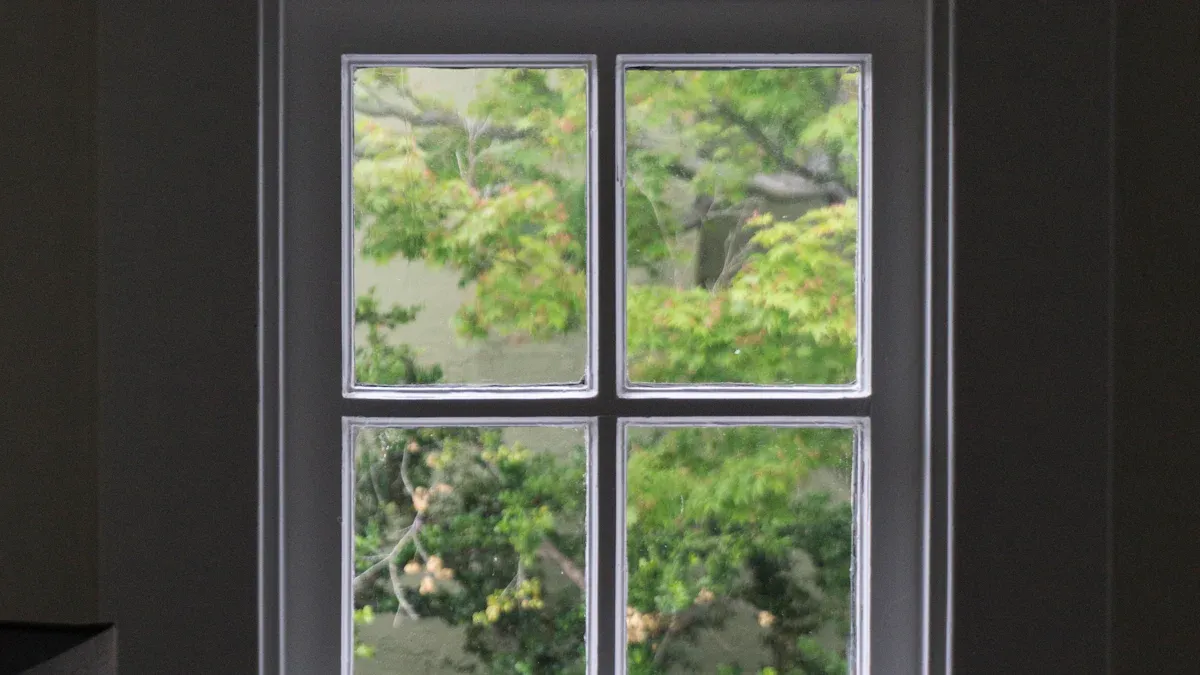Top Window Replacement Trends for 2025

Staying updated, and replace windows in 2025 is crucial. It helps make homes more energy-efficient and stylish. New windows are transforming how people save energy and design their homes. They can reduce heating and cooling energy use by 25%–30%, which lowers utility bills and keeps homes comfortable inside. The market for energy-saving windows is expanding rapidly, expected to grow from $12.53 billion in 2024 to $13.26 billion in 2025. This indicates that more people are seeking energy-efficient home solutions.
Innovative technologies like Low-E glass and specialized coatings enhance these windows' effectiveness. They help maintain your home’s temperature and promote green living. Modern designs also align with today’s home aesthetics, offering sleek appearances. If you’re considering an upgrade, now is an excellent time to explore these options. Additionally, be sure to list your business in our home services directory to connect with homeowners in need of window replacement in 2025 assistance.
Key Takeaways
Energy-saving windows can cut your energy bills by 25%-30%. They make your home cozy and help you save money.
Smart windows let you adjust light and privacy easily. This makes your home more comfy and saves energy too.
Using green materials like recycled aluminum and fiberglass helps the planet. It also makes your home look better.
New window styles, like frameless or big windows, look cool. They also bring more nature into your home.
Changing old windows can raise your home's value by 70%-85%. It's a good way to invest in your home's future.
New Trends in Window Replacement
Energy-Saving Windows
Low-E coatings and triple-pane glass
Energy-saving windows are a big focus for 2025. Low-E coatings and triple-pane glass are major improvements in window tech. These coatings keep heat inside during winter and block heat in summer. This helps keep your home cozy and saves energy. Triple-pane glass adds extra insulation, making windows work even better.
In 2025, window designs use eco-friendly materials and smart technology. People want windows that look good and save energy. These options help lower bills and protect the environment.
Gas-filled windows for better insulation
Gas-filled windows make homes even more energy-efficient. They use gases like argon or krypton between glass layers to trap heat. This keeps homes warmer in winter and cooler in summer. Choosing these windows can cut energy costs and make your home more comfortable.
New materials and designs make windows better at keeping heat in winter and blocking it in summer. This means lower bills and a cozier home all year.
Smart Window Technology
Changeable tint and privacy features
Smart windows are changing how we manage light and privacy. You can adjust their tint to control sunlight during the day. This makes your home more comfortable and saves energy. Some smart windows let you change how clear they are, giving you more control over privacy and lighting.
Smart glass changes from clear to tinted quickly.
Some windows show digital info on the glass.
They work well with smart home systems for added features.
Works with smart home systems
Smart windows connect easily to smart home setups. You can control them with a phone app. This lets you adjust light, air, and even check security from anywhere. Features like auto-tinting and temperature control keep your home comfy and energy-efficient.
Use a phone app to control windows remotely.
Change light and air settings from any location.
Link windows to other smart home devices for better security.
Eco-Friendly and Strong Materials
Green choices like recycled materials
Eco-friendly materials are a big trend in windows. Many companies now use recycled aluminum and wood from sustainable sources. Recycled aluminum is strong and energy-efficient. Wood gives natural insulation and a classic look. These materials are good for the planet and work well.
Recycled aluminum: Long-lasting and resists rust.
Sustainable wood: Renewable, biodegradable, and insulates well.
Fiberglass: Great insulation and made from recycled glass.
Tough materials for harsh weather
Strong materials like fiberglass and composites are great for tough climates. Fiberglass insulates well and handles bad weather. Composites, often made from recycled stuff, save energy and need little upkeep. These materials keep windows working well for a long time.
Scientists are creating smart windows that save energy and improve comfort. These windows manage light and heat better, making homes more efficient and pleasant to live in.
Modern Home Design Trends
Frameless and minimalist window designs
Frameless windows are changing how homes look in 2025. These modern windows skip thick frames, giving a smooth, clean style. They blend into walls easily, making rooms feel bigger and open. This trend matches the love for simple and useful home designs.
These windows also improve your view. Without big frames, you see more of the outside, like cityscapes or gardens. Some people pick bold colors or special finishes to show their style. These windows look great and save energy when used with double or triple-pane glass.
Tip: Pair frameless windows with eco-friendly shades like bamboo for style and sustainability.
Larger windows for natural light and indoor-outdoor connection
Big windows are a key part of 2025 home design. They let in more sunlight, making rooms brighter and welcoming. Natural light isn’t just pretty—it helps you feel better and cuts down on using lights.
Floor-to-ceiling windows are very trendy. They bring the outdoors inside, making spaces feel larger. This design connects you to nature, whether through wide views or sliding doors to a patio. These windows are perfect for linking indoor and outdoor areas.
Note: Large windows with smart tech can adjust light and temperature, saving energy and adding convenience.
Using these trends, you can make your home stylish, bright, and energy-efficient while enjoying nature’s beauty.
Benefits of Following Window Replacement Trends
Energy Efficiency
Lower utility bills by 25%-30%
Switching to energy-efficient windows can save you money. These windows keep heat inside during winter and block it in summer. This makes your home cozy all year. Families with single-pane windows can save $126 to $465 yearly. Even upgrading double-pane windows saves $27 to $111 per year. Double-pane windows can cut energy costs by 13%, saving up to $500 annually. These savings make replacing windows a smart idea for saving energy.
Tax credits for energy-efficient windows in 2025
In 2025, you can get tax credits for energy-saving windows. The windows must meet government rules for reducing heat loss and gain. ENERGY STAR-certified windows qualify for these credits. You can claim 30% of the cost, up to $600, for windows installed from January 1, 2023, to December 31, 2032. To apply, use IRS Form 5695 and include receipts and certifications. These credits make upgrading windows more affordable.
Enhanced Home Value
70%-85% ROI on window replacements
Replacing windows is a great way to improve your home. You can get back 70%-85% of the cost when selling. Energy-efficient windows can raise your home’s value by thousands. They also attract buyers by lowering energy bills and boosting efficiency. This makes window replacement a smart financial choice.
Better curb appeal and marketability
New windows make your home look better and more modern. Sleek designs and updated materials attract buyers. A better-looking home stands out in the market. Whether you pick simple styles or big windows for sunlight, these changes improve both looks and function.
Improved Comfort and Functionality
No drafts and steady indoor temperatures
Modern windows stop drafts and keep temperatures steady. Better insulation and weatherstripping block air leaks. Low-E coatings reflect heat inside during winter and block it in summer. These features save energy and make your home more comfortable.
Quieter living spaces with noise reduction
New windows also reduce outside noise, making your home quieter. Special materials and designs block sound from entering. This is helpful if you live near busy streets or noisy areas. A quiet home helps you relax and feel better.
Tip: Energy-efficient windows save money and create a peaceful, comfy home for better living.
Top Window Styles and Materials for 2025

Popular Window Styles
Double-hung and casement windows
Double-hung windows are loved for their classic look and usefulness. Both top and bottom parts can open, improving airflow. They are easy to clean and work well in any home style. These windows are a flexible option for your next upgrade.
Casement windows are great for saving energy. They open outward with a crank and seal tightly when shut. This design blocks drafts and keeps your home’s temperature steady. Their modern style adds beauty and makes them very practical.
Bay, bow, and sliding windows
Bay and bow windows add charm and extra space to rooms. They stick out from the wall, giving wide outdoor views. These windows bring in more sunlight, making your home brighter and cutting down on light use.
Sliding windows are another trendy choice for 2025. They slide sideways, making them simple to use in small spaces. Their big glass panels let in lots of light and offer great views. These windows improve your home’s look and energy efficiency.
Tip: Use colorful frames with these styles to show your personality and make your home stand out.
Preferred Materials for Replacement Windows
Vinyl for affordability and durability
Vinyl windows are popular because they are cheap and last long. They resist water and keep heat inside, saving energy. Vinyl comes in many colors and styles to match your home’s design.
Fiberglass for energy efficiency and low maintenance
Fiberglass windows are strong and save energy well. They last a long time and need little care, making them a good choice. Their sleek design allows for bigger glass areas, giving homes a modern feel.
Wood for timeless aesthetics and customization
Wood windows are beautiful and can be customized easily. They mix natural wood inside with a tough outside layer. With care, they last for years and add warmth to your home.
Note: Using recycled wood or fiberglass supports eco-friendly trends, making your windows stylish and good for the planet.
Energy Efficiency and Sustainability in Window Replacement

Improvements in Energy Efficiency
Benefits of Energy Star-certified windows
Energy Star windows are great for saving energy. They follow strict rules to stop heat loss and block extra sunlight. These windows help lower your energy bills and are better for the planet. Plus, you can get tax credits when you choose them, making them a smart and eco-friendly option.
Tip: Always check for the Energy Star label to pick the best energy-saving windows.
Why U-factor and SHGC matter
Knowing U-factor and SHGC ratings helps you pick better windows. The U-factor shows how well a window keeps heat inside. A lower U-factor means it keeps your home warmer in winter. SHGC tells how much sunlight heat gets through the window. A low SHGC is good for hot places, while a high one helps in cold areas. These ratings make sure your windows work well in any weather.
U-factor: Lower numbers mean better warmth in winter.
SHGC: Pick low for hot areas, high for cold ones.
Eco-Friendly Manufacturing
Using recycled materials for windows
Window makers now use recycled stuff like aluminum and glass. This cuts waste and saves resources. Recycled aluminum is strong and saves energy. Recycled glass can be reused in other ways. Choosing these windows helps the planet and reduces waste.
About 85% of U.S. windows are replaced too soon. Using recycled materials helps fix this problem.
Designs that lower carbon footprints
Companies now make windows with eco-friendly designs and methods. Special coatings and strong frames last longer, so they need fewer replacements. Factories also save energy and water during production. Many brands earn green certifications like LEED and Energy Star, proving they care about the environment.
Note: Picking windows with green certifications supports eco-friendly companies and practices.
Installation and Cost Considerations for Replacement Windows
Professional Installation Tips
Why sealing and insulation matter
Sealing and insulation are key for windows to work well. Small gaps can let in drafts, making insulation less effective. Follow these simple steps to avoid problems:
Pick the right material based on your needs and size.
Cut the material to match the frame’s exact size.
Test the fit before installing to ensure it’s tight and secure.
Using the wrong sealant can cause poor sticking, reducing insulation. Regular checks help stop air, wind, and water from getting inside. Fixing these details improves energy savings and keeps your home cozy.
Why hire certified installers
Certified installers know how to fit windows perfectly. They measure correctly, ensuring a snug fit that saves energy. Their skills lower the chance of future problems, saving repair costs. Many certified pros also offer warranties for their work and the windows, giving you extra security.
Tip: Certified installers follow strict rules, preventing leaks and drafts. This ensures your windows last longer and perform better.
Costs and Money-Saving Options
Typical costs by window type
Window replacement costs depend on the material you pick. Here’s a simple cost guide for 2025:
Window Frame Type | Average Cost Per Window |
|---|---|
Vinyl Windows | $391 to $834 |
Aluminum Windows | $397 to $846 |
Fiberglass Windows | $320 to $683 |
Wood Windows | $875 to $1,865 |
Composite Windows | $950 to $1,800 |
Choose materials based on your budget and style. Vinyl and fiberglass are affordable and strong. Wood and composite look great but cost more.
Tax credits and rebates for savings
In 2025, you can save money with tax credits for energy-efficient windows. These credits cover up to 30% of the cost (up to $600). Some utility companies also offer rebates, sometimes over $200 per window. These programs make eco-friendly windows cheaper and help lower energy bills.
Note: Check with your utility company for rebates. Make sure your windows meet Energy Star rules to qualify for savings.
The top window replacement trends for 2025 bring exciting changes. Key points include:
Bold Colors: Bright window frames make homes stand out and look great.
Sustainability: Using recycled materials like steel and wood helps the planet.
Multi-Functional Designs: New windows offer better air, safety, and smart features.
Automation in Treatments: Simple, automatic shades add style and are easy to use.
Modern windows help make homes greener. Materials like fiberglass and composite save energy and cut bills. Better insulation, like triple-pane glass and Low-E coatings, keeps heat in or out. This means less need for heating or cooling systems. These upgrades save energy, add value, and make homes cozier.
By following these trends, you can have a stylish and eco-friendly home. Try these ideas to enjoy a brighter and more efficient space. 🌿
FAQ
What are the main benefits of replacing windows in 2025?
Replacing windows saves energy, lowers bills, and makes homes cozier. New designs also increase your home's value and look. You’ll get better insulation, less noise, and tax credits for upgrades.
Tip: Pick Energy Star-certified windows for the best savings and comfort.
How do I know if my windows need replacement?
Watch for drafts, foggy glass, or hard-to-open windows. High energy bills or cracks and warping are also signs. Checking your windows often helps you spot problems early.
Are larger windows harder to maintain?
Not always. Many big windows use strong materials like fiberglass or vinyl. These need little care. Some even have self-cleaning glass to make upkeep simple. Clean and check them regularly to keep them working well.
Can I install replacement windows myself?
You can try, but it’s not a good idea. Bad sealing or fitting can cause drafts and waste energy. Hiring certified pros ensures proper fitting and better insulation. They often include warranties for extra security.
Note: Professional installation saves energy and avoids costly errors.
What is the average lifespan of modern replacement windows?
Modern windows last 20–30 years with good care. Vinyl and fiberglass are durable and need little maintenance. Wood windows need more care but look classic. Cleaning and checking them often helps them last longer.
Reminder: Look at warranties for extra protection and peace of mind.
See Also
Innovative Roofing Ideas for Contemporary Residences
Cutting-Edge Home Security Innovations for the Year 2025
Transformative Developments in Solar Panel Setup for 2025
Essential Advice for Selecting Garage Door Providers in 2025
